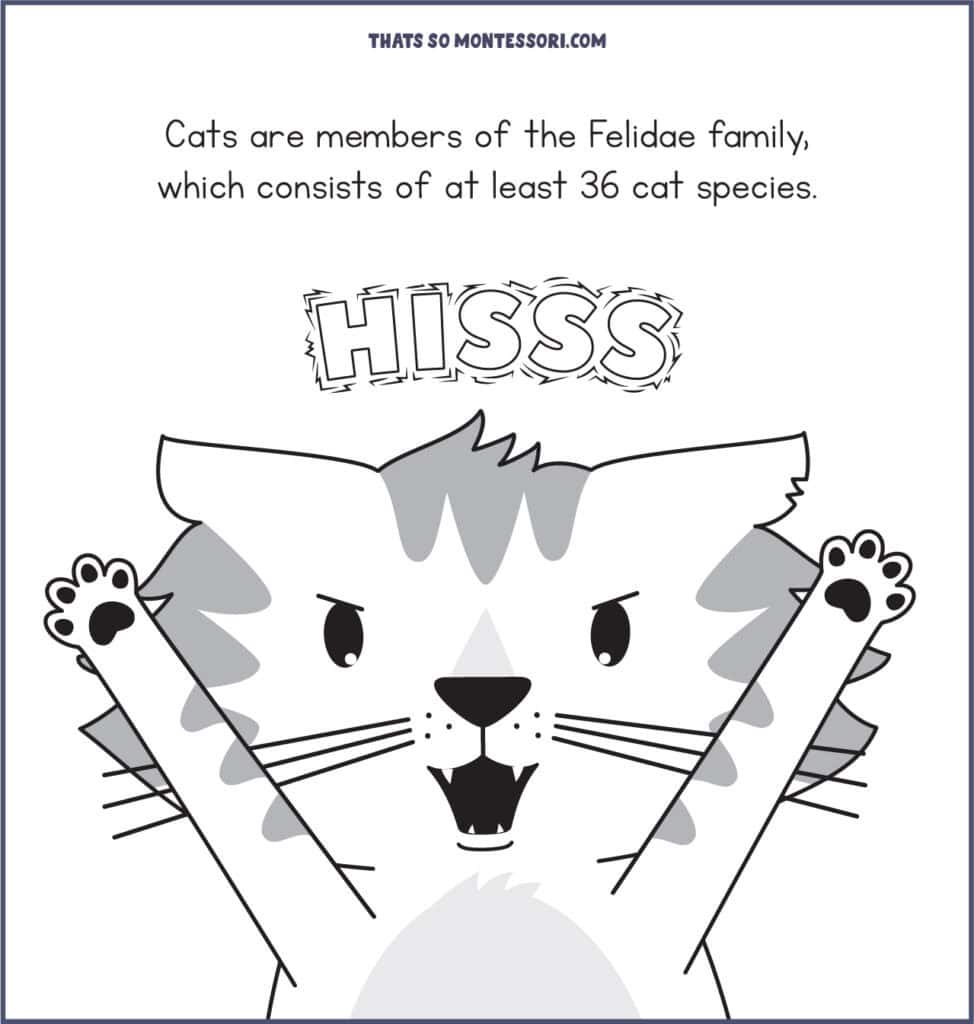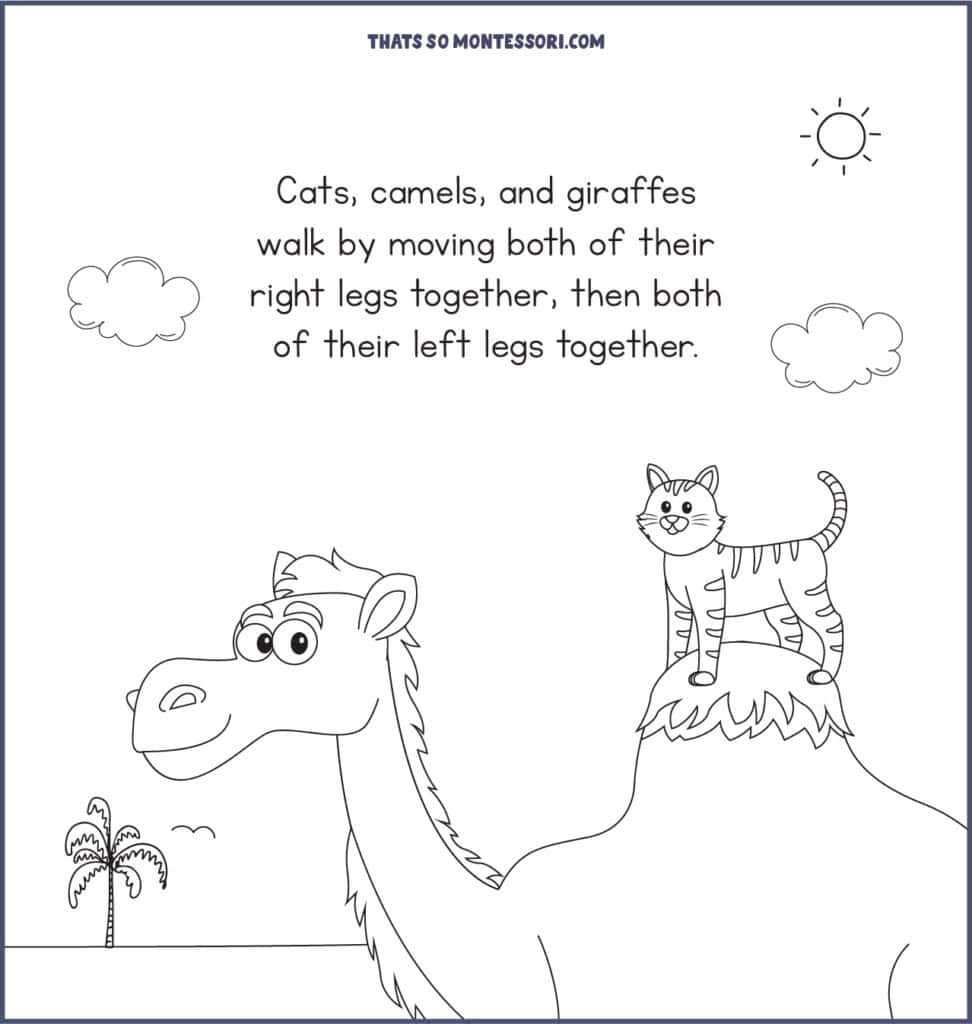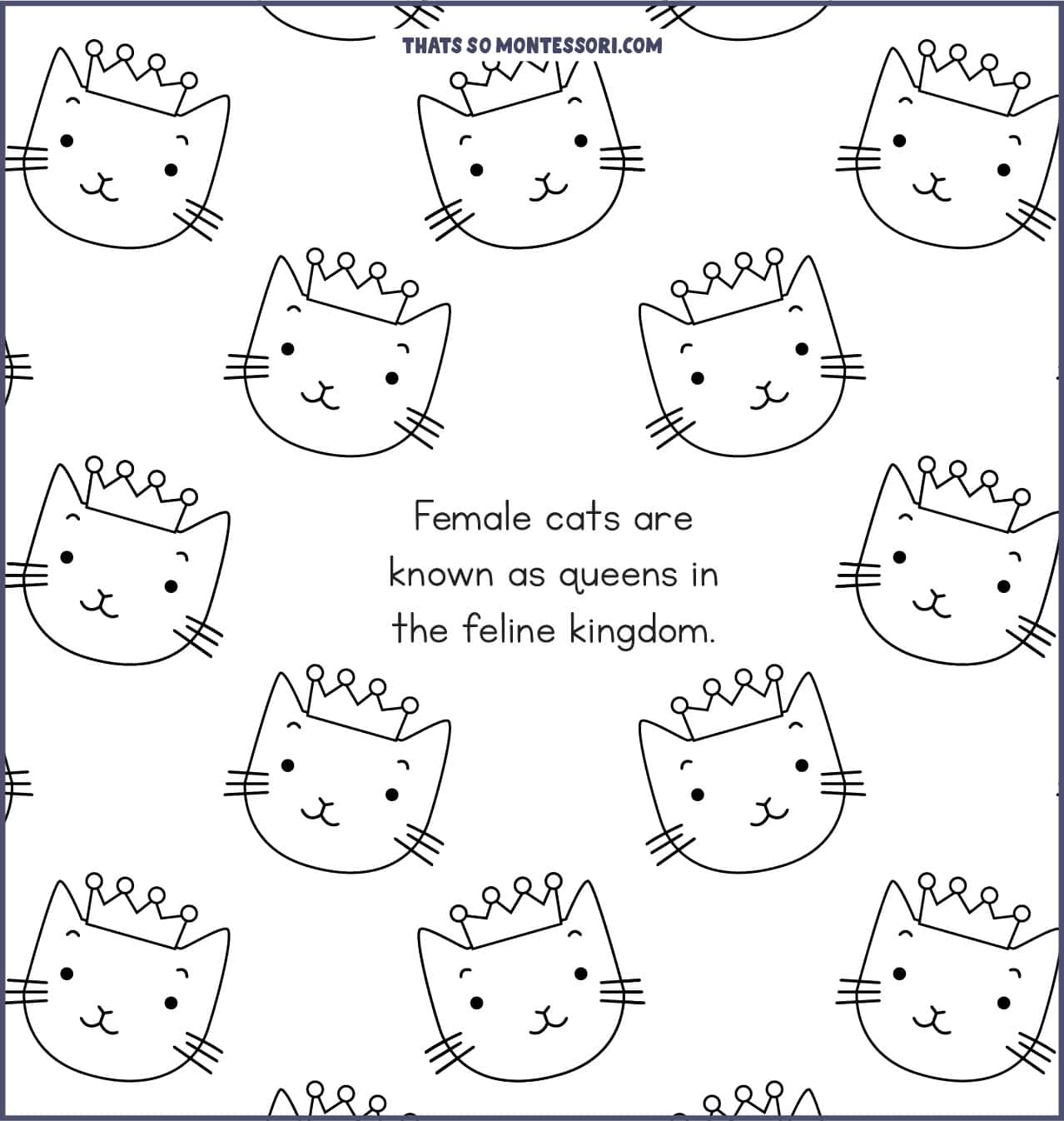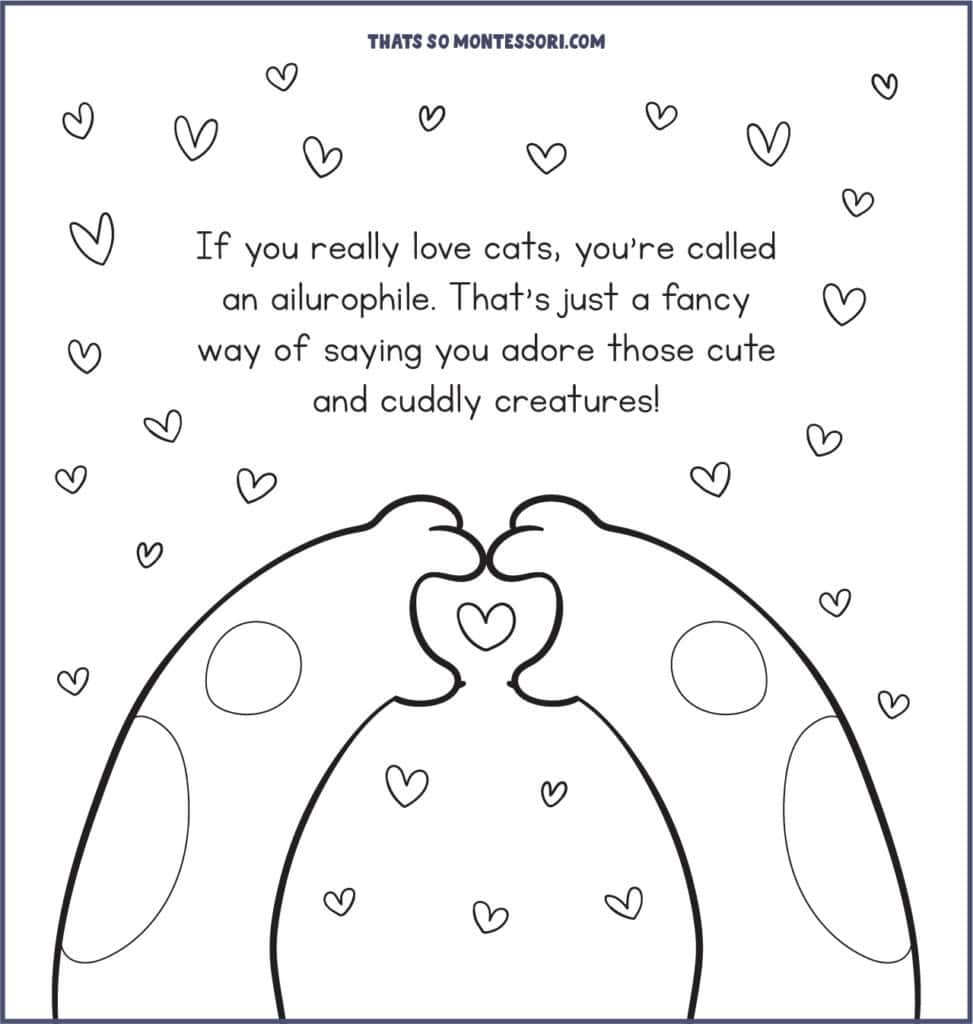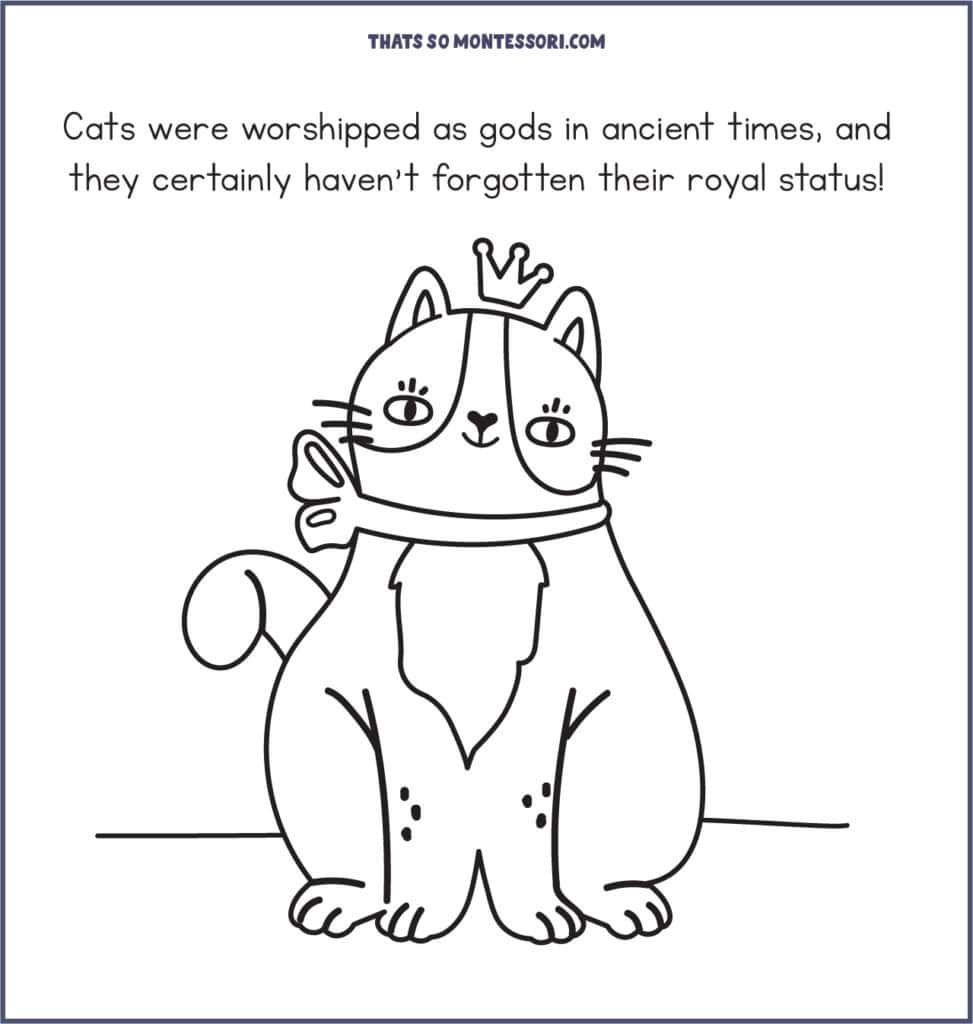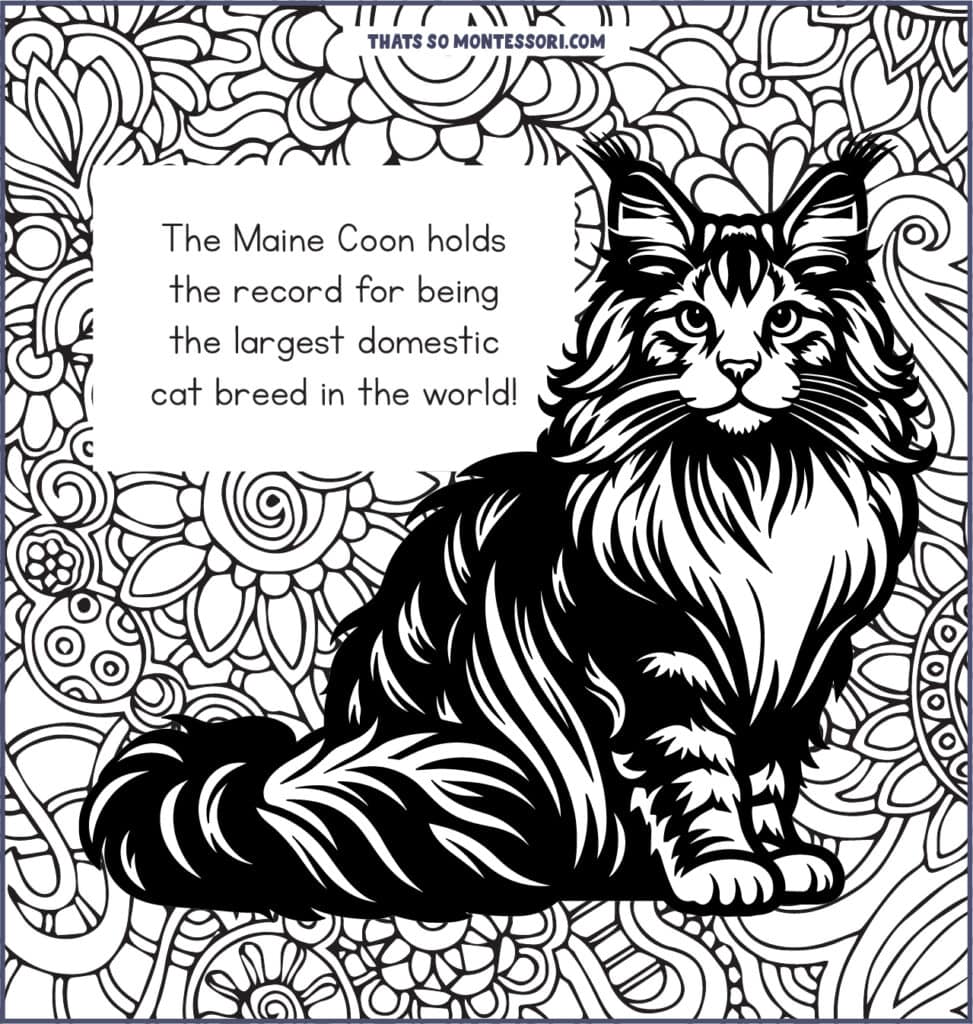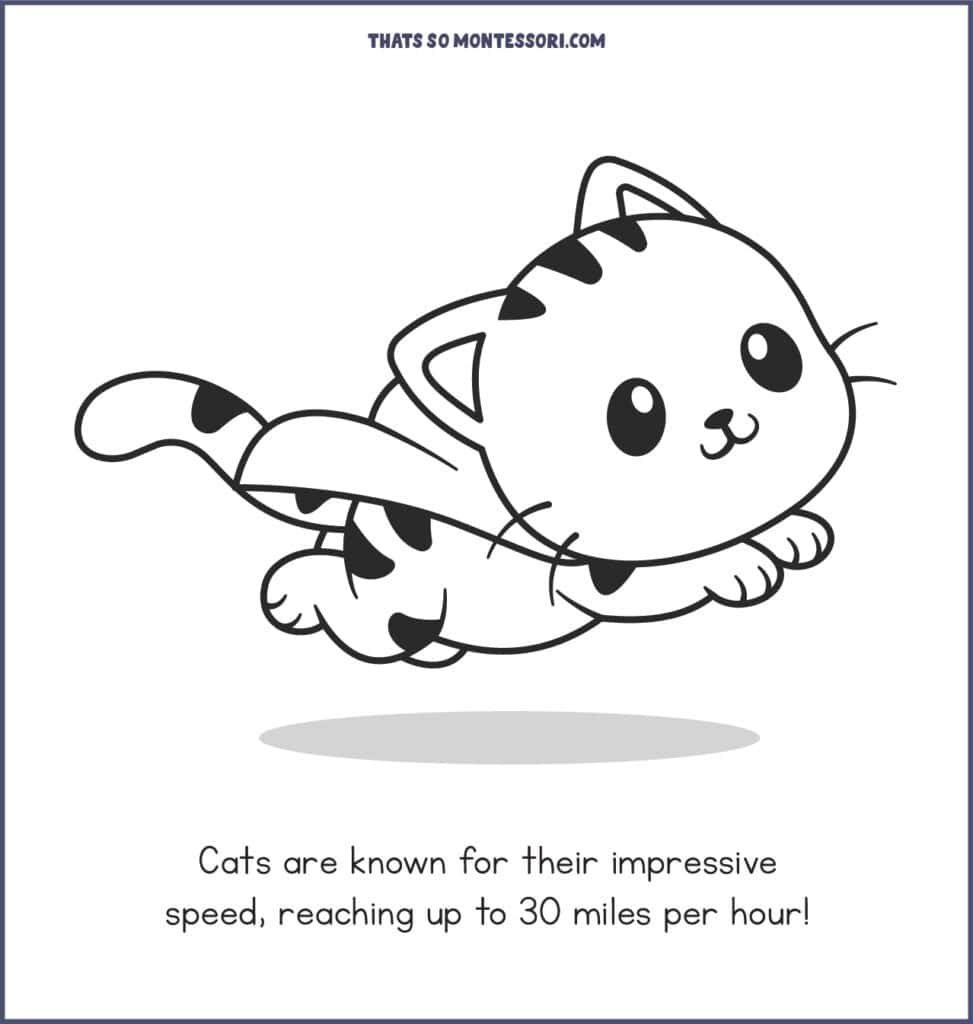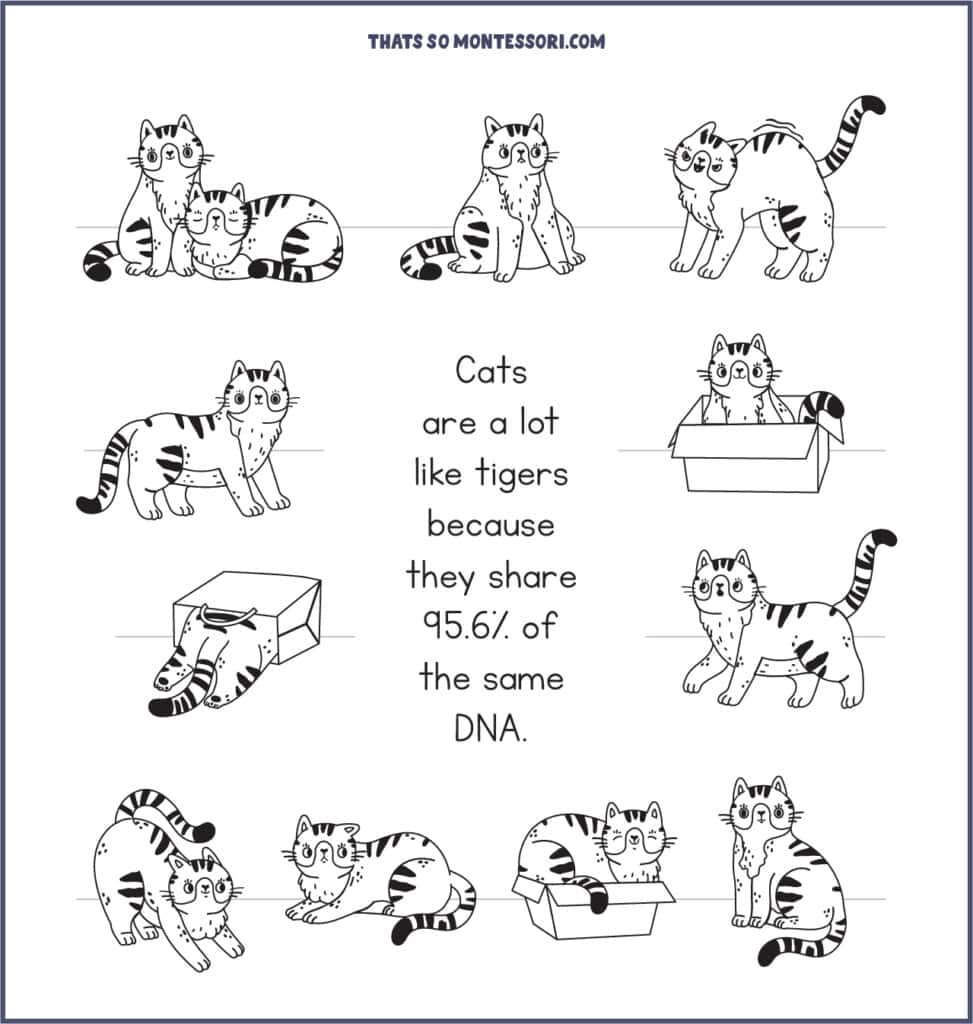33 Cat Facts for Kids: Fascinating Insights about Felines
Step into the fascinating world of cat facts for kids, where every whisker, purr, and playful paw presents invaluable teachable moments!
Cats have a special place in the hearts of children, captivating them with their independent spirit, graceful movements, and adorable antics. Whether your kids are devoted cat lovers or simply curious about these mysterious creatures, this compilation of cat facts for kids is sure to tickle their curiosity and deepen their appreciation for our feline friends.
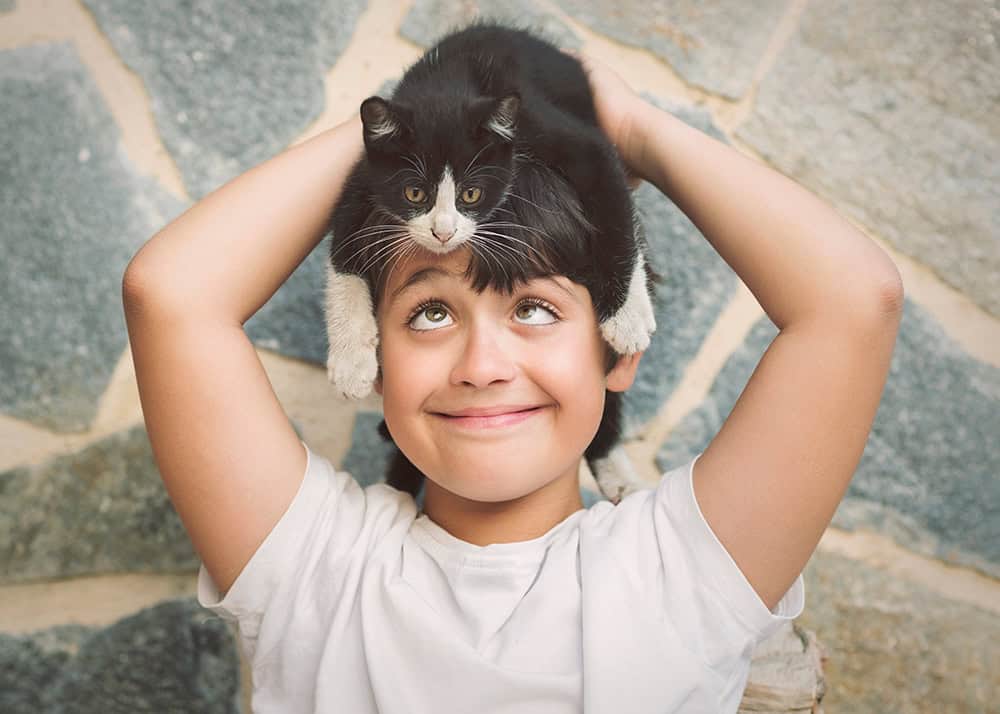
33 Cat Facts for Kids
Get ready for a purr-fect learning in disguise experience as we share some fascinating cat facts for kids!
It’s time to take a closer look at the enchanting world of felines and discover some surprising secrets along the way.
Anatomy and Physiology Cat Facts for Kids
Fact #1: Cats are members of the Felidae family, which consists of at least 36 cat species.
Those adorable and beloved pets that curl up on our laps and playfully pounce on toys are proud members of the Felidae family, which includes domestic cats and their majestic relatives – the big cats.
Members of the Felidae family include over 36 species of wild cats. These felids share common physical traits such as rounded, flat faces, facial whiskers, large eyes, and large ears.
The cat family exhibits a diverse range of body sizes, spanning from 1 kilogram to 300 kilograms, making them the most varied in size among all carnivore families. Learn more about wild cats in The Big Book of Wild Cats: Fun Animal Facts for Kids.
So, the next time you see your pet cat pouncing around, remember that lurking beneath that adorable exterior is a ferocious beast with a lineage stretching back to the fierce big cats!
💡 Related Blogs
This is One of the Best Picture Books to Teach Vocabulary And I’ll Tell You Why
27 Cat Picture Books for Kids Who Love Cats
Fact #2: Cats have an extraordinary sense of balance.
Cats are renowned for their exceptional balance, a trait that contributes to their graceful and poised demeanor. Their unique inner ear structure enables them to navigate narrow ledges and high surfaces with remarkable ease and confidence.
Their incredible sense of balance is used for hunting, and it adds to their mesmerizing charm as they move gracefully with captivating precision.
Fact #3: Some cat paws look like mittens.
Some cats have an interesting genetic trait called polydactylism, which means they have extra toes on one or more of their paws.
Typically, cats have five toes on their front paws and four on their back paws. However, polydactyl cats can have more toes, sometimes resembling adorable fuzzy mittens.
Polydactylism can occur in various cat breeds and is often passed down through genetics. While having extra toes may not provide any significant advantages for the cat, it certainly adds to their individuality and charm.
Fact #4: Cats have an acute sense of smell.
Cats have an incredible sense of smell that’s much stronger than ours. They can pick up on all sorts of smells that we can’t even notice!
This heightened sense of smell helps them find their way around, figure out what’s food, and even talk to other cats by leaving scent marks. It’s like they have a secret language they can understand just by sniffing!
Ever wondered why your cat rubs against things or scratches? They’re actually marking their territory and communicating with other cats through scent. It adds a whole new meaning to ‘smell ya later!’
Fact #5: Cats have a third eyelid.
Cats have a fascinating feature called a nictitating membrane which is like a hidden eyelid that helps protect their eyes. This keeps their eyes moist and clean, acting as a shield against dust and debris.
The presence of a third eyelid is a common trait in many mammals, serving as a fascinating adaptation that contributes to a cat’s well-being and health. It acts as a protective shield for their eyes, ensuring they remain safe during their adventures.
Fact #6: Cats, camels, and giraffes walk by moving both of their right legs together, then both of their left legs together.
Cats walk like camels and giraffes because they use a unique walking style called “pacing.”
Unlike many other animals that move their front and back legs on opposite sides in a diagonal pattern (known as “trotting” or “running”), cats place both left legs forward followed by both right legs. This distinctive gait allows them to conserve energy while walking and helps them move smoothly over various terrains with grace and efficiency.
Pacing is not common among most quadrupeds but is a characteristic feature of certain animals like camels, giraffes, and, of course, cats.
Fact #7: Cats have tiny hooks on their tongues.
Cats are very good at keeping themselves clean! This is thanks to their special built-in grooming tool. You see, cats have tiny, hook-like structures called papillae on their tongues. These tiny hooks help them groom themselves by grabbing onto dirt, debris, and loose hair in their fur.
This grooming not only keeps them looking neat but also helps them feel good. It’s like they’re doing their own version of a spa day!
Fact #8: Cats can rotate their ears.
Ever notice how your cat’s ears seem to move independently, almost like they have a mind of their own? Well, it’s not just your imagination. Cats have a remarkable ability to rotate their ears up to 180 degrees, giving them a wide range of hearing.
This means they can pick up on even the quietest sounds, whether it’s the scurry of a tiny mouse or the whisper of a bird’s wings. In the wild, this incredible ear mobility is essential for survival. It allows cats to stay vigilant and alert to potential threats or prey lurking nearby.
Fact #9: Cats have unique taste buds.
Cats have only about 473 taste buds. That’s way fewer us humans, who have a whopping 9,000, and even dogs, who have around 1,700 taste buds! While cats can taste savory, salty, bitter, and sour flavours, they miss out on the sweetness that we humans enjoy.
Their specialized taste buds are perfectly suited for their carnivorous lifestyle, allowing them to savour the flavours of meat while ignoring the sugary temptations that may entice other animals.
Fact #10: A cat’s retractable claws are like built-in tools they can use whenever needed.
Unlike dogs, whose claws are always exposed, cats have the unique ability to retract their sharp claws when they’re not in use. This feature is particularly useful for hunting; cats can keep their claws safely tucked away while they quietly stalk their prey, only extending them at the last moment for a quick and efficient capture.
But retractable claws aren’t just for hunting – they’re also handy for climbing. Cats can extend their claws for better grip when necessary. And when they’re done climbing, they can retract them again, keeping them safe from getting caught on anything.
Fact #11: Cats Have a Unique Collarbone That Allows for Flexibility.
Cats have a fascinating skeletal feature that sets them apart from many other animals – their collarbone, also known as the clavicle, is incompletely fused. This means that it’s more flexible than in other animals, allowing cats to move their shoulders and front legs with incredible fluidity.
This unique collarbone structure gives cats the ability to navigate tight spaces effortlessly, squeeze through narrow openings, and twist their bodies with agility, making them exceptional climbers and hunters.
Fact #12: Cats have an average of 24 whiskers on their face
Cats’ whiskers, also known as vibrissae, are more than just cute features on their faces – they’re essential tools for navigating the world around them! With an average of 24 whiskers, 12 on each side of their face, cats use these specialized hairs to gather information about their surroundings.
Their whiskers are incredibly sensitive and can detect even the slightest changes in the air, helping cats sense nearby objects and obstacles. When a cat’s whiskers brush against an object, it sends signals to their brain, providing valuable information about the object’s size, shape, and texture.
Fact #13: Cats have a heightened sense of night vision
Cats can see remarkably well in the dark! This impressive skill comes from a special layer in their eyes called the “tapetum lucidum,” which acts like a mirror, reflecting light and making everything brighter, even in low-light conditions.
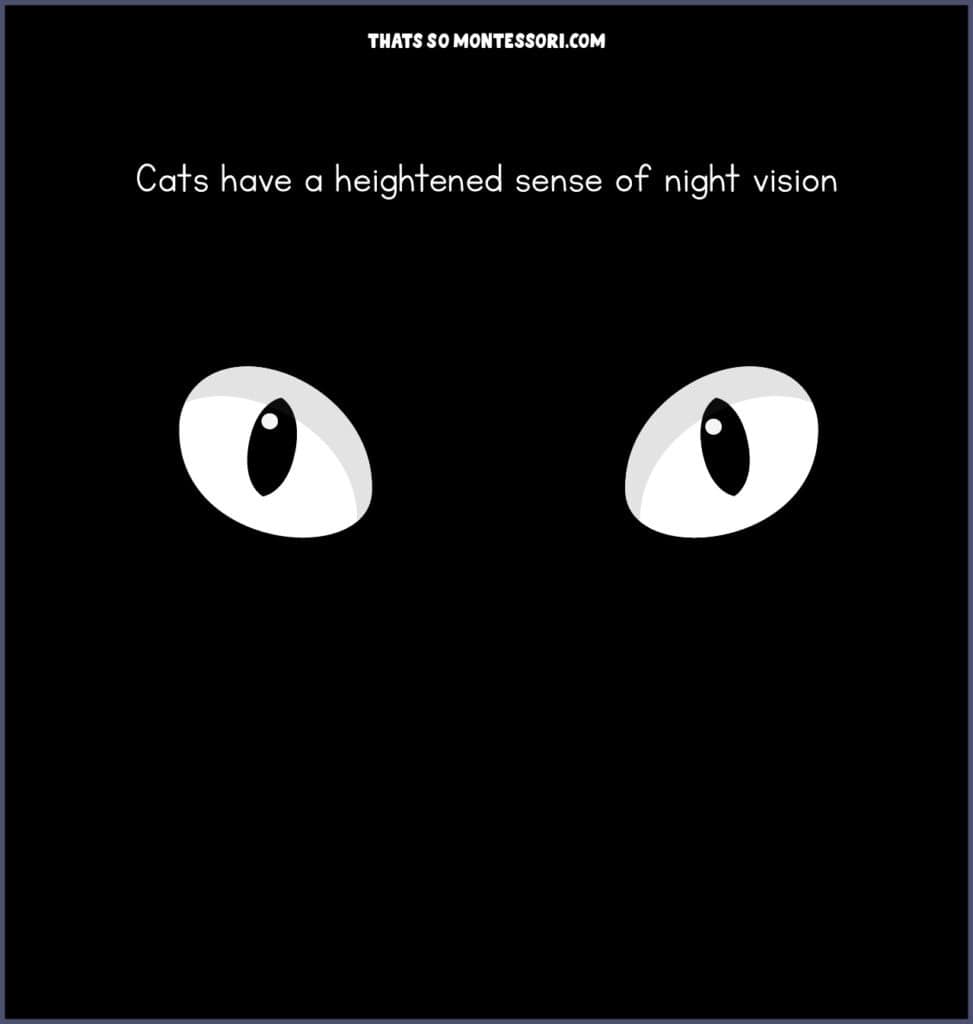
A cats’ eyes are equipped with more light-sensitive cells than human eyes, allowing them to detect even the slightest movements in the dark. While we might struggle to see in dimly lit areas, cats have no trouble at all.
It’s like cats have their own night-vision goggles. This is a characteristic that gives them an edge in the animal kingdom!
Fact #14: A cat’s nose print is unique.
Similar to how human fingerprints are unique, each cat possesses a distinct nose print that distinguishes them from all others. This intricate pattern serves as a reliable form of identification.
Unlike whiskers or coat colours, a cat’s nose print remains unchanged over its lifetime. This ensures accurate identification and highlights the wonder and individuality of each feline companion.
Behavioural and Socialization Cat Facts
Fact #15: A group of cats is called a clowder, a clutter, a pounce, or a glaring.
When multiple cats are seen together, it’s called a “clowder.” This term serves as their collective noun, and it’s not the only one they have. A group of cats can also be referred to as a “pounce,” “glaring,” or “clutter.”
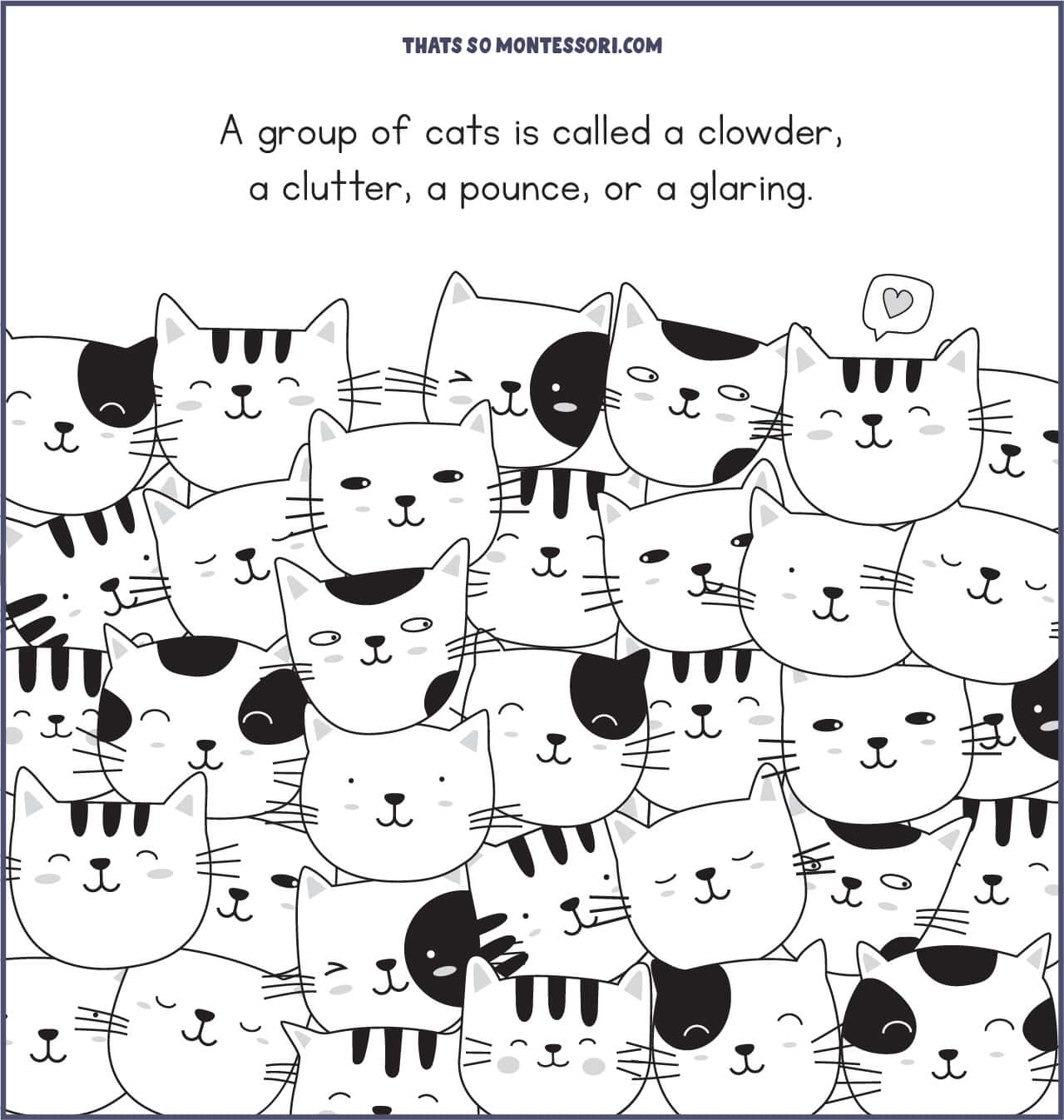
A group of kittens is called a “kindle.”
Whether they’re all snuggling together for a nap or pouncing around as they play, you can refer to a group of cats by these collective nouns.
Fact #16: The frequency of a cat’s purr promotes healing.
The soothing sound of a cat’s purr is more than just the sweetest thing, it may also have therapeutic benefits. Research suggests that the frequency of a cat’s purr, typically between 25 and 150 Hertz, can promote healing by stimulating tissue regeneration and bone density.
Additionally, the rhythmic vibrations produced by purring have been shown to lower stress levels, blood pressure, and anxiety in both cats and humans. This natural form of self-soothing not only helps cats relax but also contributes to their overall well-being.
Fact #17: Cats have grooming rituals for social bonding.
Cats’ grooming rituals extend beyond mere hygiene; they serve as a vital tool for reinforcing social connections within their feline community. Through mutual grooming, cats engage in acts of care and affection, fostering trust and camaraderie among family members.
This intimate behaviour helps maintain harmony within the clowder and reinforces the bonds that are essential for their collective well-being.
Fact #18: Female cats are known as queens in the feline kingdom.
In the royal kingdom of felines, the female cat reigns supreme and is called a “queen.” Alongside their noble title of “queen,” a female cat is also known as a “Molly.”
In contrast, a male cat is called a “tom” or “tomcat.” And of course, we can’t forget about the adorable offspring of cats, affectionately known as “kittens”!
Fact #19: The world’s oldest cat lived to be 38 years old.
Creme Puff, an extraordinary feline from Texas, surpassed the average feline lifespan by a remarkable margin. Born in Texas in August 1967, Creme Puff lived an incredible 38 years and 3 days, making her the oldest cat ever recorded in the Guinness World Records.
This cats long life wasn’t just luck; it was because her owner took really good care of her. He fed her a special diet of bacon, eggs, broccoli, and coffee with cream. But more than just the food, it was the strong bond between Creme Puff and her owner that probably helped her live so long.
Fact #20: Cats typically sleep for 12-16 hours every day.
Cats are known for their love of relaxation, often spending a significant portion of their day snoozing. In fact, the typical feline spends anywhere from 12 to 16 hours each day indulging in sweet slumber.
This seemingly excessive downtime serves a vital purpose in their hunting instincts, allowing them to recharge for those moments of feline prowess.
Fact #21: Cats communicate using various vocalizations.
Cats use a diverse range of sounds to communicate with their human friends. The classic “meow” is perhaps the most recognizable, but cats have a whole symphony of other vocalizations at their disposal.
When they’re content and relaxed, you might hear them purring softly, a sound that’s often associated with happiness and comfort. Sometimes, cats will chirp or trill, which can be a way of greeting their humans or expressing excitement about something they’ve seen.
Each vocalization has its unique meaning, and attentive pet owners can learn to understand their feline friends’ language, resulting in a deeper bond.
Fact #22: Cats Use Their Whiskers to Tell if They Can Fit in Spaces
Whiskers, also knows as vibrissae, are the ultimate navigational tool for cats. These sensitive, specialized hairs extend far beyond a cat’s body, allowing them to assess the width of openings and therefore potential passageways.
When a cat’s whiskers are gently brushed against the sides of an opening, it provides vital information about whether they can safely fit through without the risk of getting stuck. These whiskers act as their trusty guides, helping cats gracefully navigate their surroundings with precision and avoid any unwelcome mishaps.
💡 Did you know that cats also have whiskers on their legs?
You’ll find them on their wrist, and they’re called carpal vibrissae.
These leg whiskers help cats sense the ground they walk on. They detect tiny changes in air pressure and temperature, helping them spot threats or prey nearby.
Fact #23: Some cats are excellent swimmers.
Would you believe that some cats are excellent swimmers? Contrary to the common belief that cats dislike water, breeds like the Turkish Van and Maine Coon defy this stereotype with their love for aquatic fun!
These water-friendly felines not only enjoy swimming but also excel in it, effortlessly gliding through the water with grace and agility.
From pouncing into ponds to paddling around in a bathtub, these cats have quite the adventurous spirit.
Fact #24: Cats are stealthy hunters.
Cats are nature’s ultimate stealth predators, showcasing remarkable hunting abilities with a blend of stealth, patience, and heightened senses. Through these skills, they become adept at stalking and capturing their prey.
Their sharp vision, acute hearing, and sensitive whiskers empower them to detect even the faintest movements and vibrations, allowing them to excel as hunters regardless of the time of day.
Through a combination of agility and precision, cats demonstrate unparalleled hunting skills, making them excellent predators in various environments. Whether prowling through the underbrush of the jungle or silently stalking a toy under a blanket at home, cats showcase their stealth with every hunt.
💡This Glaring of Cats is in The Best Ever Cat Facts Coloring Book!
Full of adorable cats and intriguing feline facts, this fun coloring book is great for cat lovers of all ages!
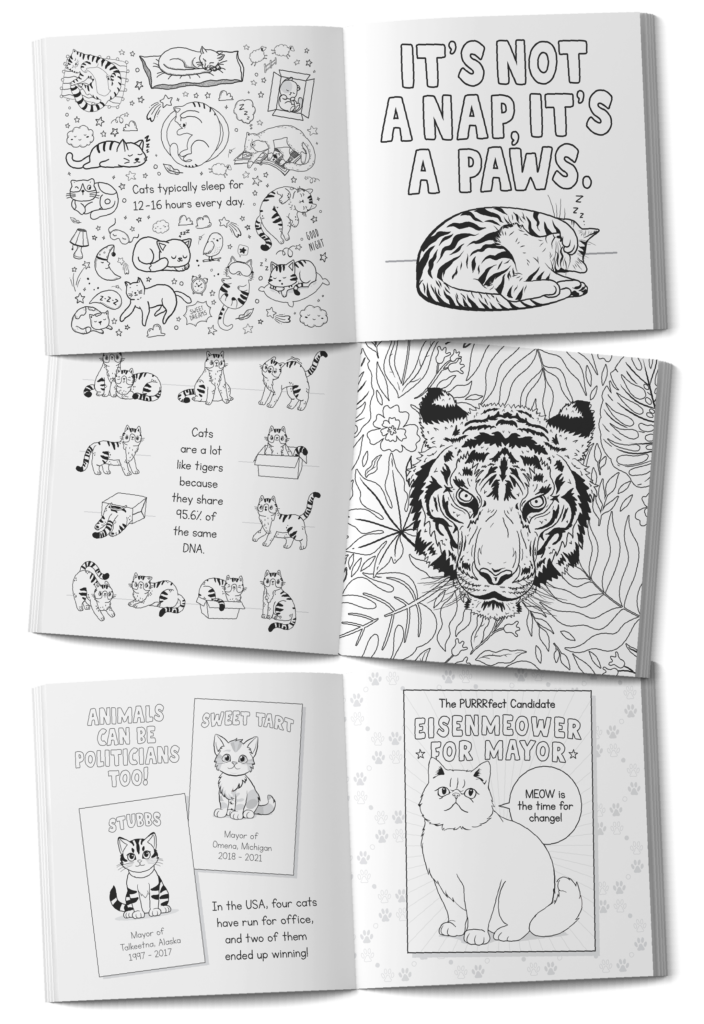
Bet You Didn’t Know Cat Facts for Kids
Fact #25: If you really love cats you’re called an ailurophile.
Ailurophile (pronounced ay-luh-ruh-fahyl) is a term used to describe people who have a very strong affection for cats.
Ailurophiles often find joy in spending time with their feline friends, whether it’s playing games, cuddling up for a nap, or simply enjoying each other’s company. They take delight in observing cats’ curious antics and quirky habits, finding endless fascination in their playful nature and independent spirit.
For ailurophiles, cats are not just pets but cherished members of the family, bringing comfort, companionship, and unconditional love into their lives. Being called an ailurophile is a badge of honour that signifies a special bond with these beloved animals and a lifelong commitment to their care and well-being.
Fact #26: Cats were worshipped as gods in ancient times, and they certainly haven’t forgotten their royal status!
Ancient Egyptians held cats in high esteem, considering them sacred creatures associated with powerful goddesses like Bastet, who symbolized home, fertility, and protection.
These adorable animals were not just pets but revered companions, believed to bring blessings and good luck to their households. Egyptians decorated their homes with images of cats and even mummified them as a sign of respect for their divine connection.
Cats are still loved all over the world today, a testament to just how special they are. And of course, they know they’re amazing, which is why we love them so much!
💡 Not sure what ‘revere‘ means? We’ve got you covered!
revere (verb) {re-vere}
To respect or admire greatly.
If you find this helpful you’ll love our Word of the Week digital slides!
And you’ll also want to check out these blogs:
This is One of the Best Picture Books to Teach Vocabulary And Here’s Why
25 Best Picture Books with Rich Vocabulary
The Ultimate 13 Vocabulary Development Activities for Kids
Fact #27: Cats can communicate with their tails.
Cats are masters of communication, and their tails play a crucial role in expressing their emotions and intentions. When a cat’s tail is held high and swaying gently, it usually means they’re feeling happy and confident. On the other hand, if their tail is tucked between their legs, it’s a sign that they’re scared or nervous.
By paying attention to their tail movements, cat owners can better understand their feline companions and respond accordingly to their needs and emotions.
Fact #28: The smallest cat ever recorded weighed just 1.4 pounds.
Tinker Toy holds the title for being the smallest cat ever recorded, weighing a mere 1.4 pounds, which is about the weight of a small bag of sugar.
This adorable little kitty, a male blue point Himalayan-Persian from Taylorville, Illinois, stood at just 7 centimeters tall and measured 19 centimeters from nose to tail when fully grown. Tinker Toy was a pint-sized bundle of fur with a personality that could fill a room.
Despite his tiny frame, Tinker Toy’s presence was larger than life, leaving a mark on all who had the pleasure of meeting him. His petite size made him an instant sensation, capturing the hearts of cat lovers around the world and proving that sometimes, the best things in life come in the smallest packages.
Fact #29: The Maine Coon holds the record for being the largest domestic cat breed in the world!
The Maine Coon breed is renowned for its impressive size, and one cat in particular, Mymains Stewart Gilligan, or Stewie, truly stood out.
In 2010, Stewie made headlines for his extraordinary length, measuring an astonishing 48.5 inches from nose to tail. This made him the longest domestic cat ever recorded, earning him a spot in the record books.
Despite his towering stature, Stewie was known for his gentle nature and affectionate personality, captivating the hearts of everyone he encountered. His remarkable size not only made him a unique feline celebrity but also served as a testament to the grandeur of the Maine Coon breed.
Fact #30: Cats are known for their impressive speed, reaching up to 30 miles per hour.
Cats are renowned for their incredible speed, clocking in at an impressive 30 miles per hour. This lightning-fast pace allows them to swiftly navigate their environment, whether they’re chasing prey or frolicking around the house.
To put it into perspective, imagine a cat zipping through your backyard at the same speed as a car cruising down a typical road. At this impressive speed, a cat can cover considerable ground in no time, showcasing their remarkable athleticism and agility.
Fact #31: Cats can jump as high as eight feet, which is about five to six times their body length.
With powerful leg muscles and remarkable agility, felines are like acrobats. They can leap up to six times their body length. Just imagine if you could jump from one end of a school gym to the other – it’s quite the feat!

This incredible ability isn’t just for show; it serves a practical purpose in the wild. Cats use their jumping skills for hunting, allowing them to pounce on unsuspecting prey with lightning speed and precision.
And it’s not just about catching dinner – cats also use their jumping abilities for exploration and relaxation. Their agility knows no bounds!
Fact #32: Cats are a lot like tigers because they share 95.6% of the same DNA.
Cats, our beloved furry companions at home, share an astonishing 95.6% of their genetic makeup with their much larger relative, the powerful tiger!
Yes, it’s true! Despite their size difference, house cats and tigers have a lot in common, from their genes to their behaviours.
Just like tigers, domestic felines exhibit similar habits such as scent and urine marking, which they use to communicate with other cats in their territory. Additionally, both cats share the instinctive behaviour of prey stalking and pouncing, a trait that helps them survive and thrive in their respective environments.
Our Favourite Cat Fact for Kids
Fact #33: Carl the Cantankerous Cat is a cat picture book that enhances kids’ vocabulary.
Carl the Cantankerous Cat is a cat book for kids that aims to expand readers’ vocabulary in the most delightful way possible.
In this book kids follow Carl, a feisty feline with a knack for adventure, and learn about his crabby ways. Along the way, they encounter a bunch of new words like “cantankerous” and “inquisitive,” carefully sprinkled throughout the story to keep readers engaged, entertained, and learning.
Perfect for reading sessions in the classroom or snuggled up at home, Carl the Cantankerous Cat adds a splash of excitement to learning new words. With the charming cat character and vibrant illustrations, this book transforms a vocabulary-building activity into a cat loving adventure.
It’s a Fact That Kids Love Cat Facts
Kids love cat facts because these furry creatures capture their imaginations and ignite a sense of wonder. Cats are fascinating and mysterious animals that have unique qualities and behaviours, making them interesting subjects of exploration.

Reading cat facts for kids allows children to look deeper into the intriguing world of these adorable companions, satisfying their curiosity and expanding their knowledge. Whether it’s uncovering the secrets behind a cat’s agile movements, understanding their communication cues, or marvelling at their playful antics, cat facts spark joy and create a sense of connection between children and these delightful creatures.
And of course, cats often hold a special place in children’s hearts as beloved pets, making learning about them even more exciting and meaningful. Exploring cat facts for kids not only entertains children but also cultivates empathy, responsibility, and a deep appreciation for the animal kingdom.
The Best Ever Cat Facts Coloring Book
Discover the ultimate coloring adventure with The Best Ever Cat Facts Coloring Book, designed especially for kids who adore cats!
This engaging coloring book offers a ton of benefits for young minds. It provides hours of entertainment and creative expression, and also fosters learning with 15 fun cat facts for kids on every spread.

With over 200 adorable cats waiting to be brought to life, children can set off on a journey of exploration and imagination, all while honing their fine motor skills and enhancing concentration.
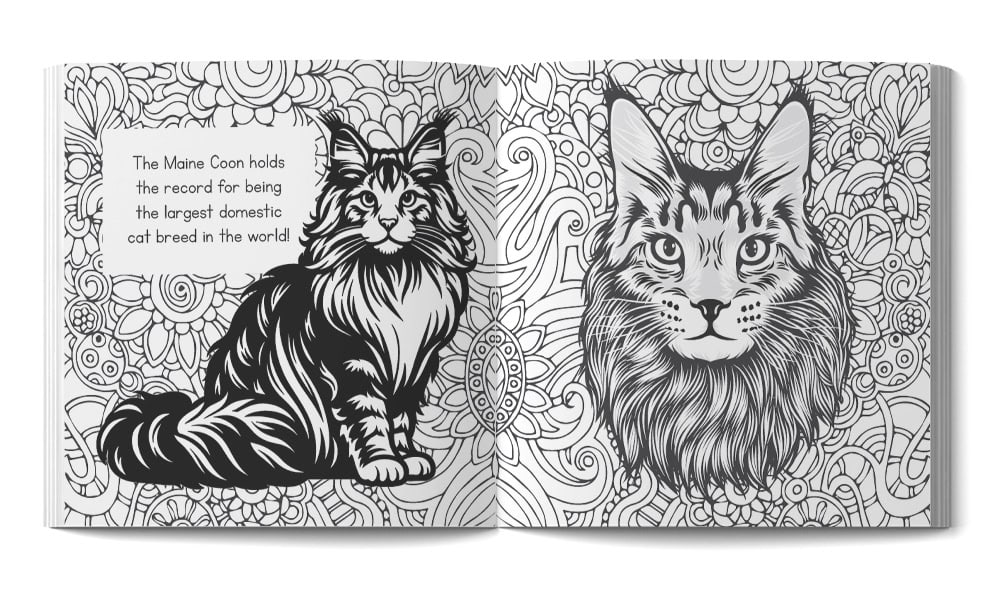
Each spread of this coloring book for kids includes a fascinating tidbit about cats, from their quirky behaviours to their unique characteristics. Kids will learn new facts as they add their personal touch to each page, making it an enriching and educational experience.

Explore the wild world of felines with this coloring book that’s packed with fascinating cat facts for kids! Let their imagination run wild as they colour in eye-catching illustrations while learning all about these fascinating felines.
The Wrap-Up: 33 Cat Facts for Kids
With access to these 33 awesome cat facts for kids, you’ll be able to impress the elementary-aged kids in your life. You’re basically a cat expert now!

Remember, cats are more than just pets, they are companions that continue to captivate us with their grace, agility, and mysterious ways. By understanding and respecting their nature, we can forge stronger bonds with our feline friends and provide them with the love and care they deserve.
Let your love for cats shine brightly as you share these fascinating cat facts with the kids in your life that are in the second plane of development. They’ll love them! Spread the joy and wonder of cats, and continue to explore the fascinating world of animals around us.
Save this blog for later by pinning it now!

Check out these blogs for more fun and engaging activities for kids:
21 Fun Math Games with Dice to Try With Kids 8-12 (+ FREE Printable Dice)
9 Montessori-Aligned Math Activities for Elementary Students
The Ultimate 13 Vocabulary Development Activities for Kids
31 Fun Summer Reading Activities Elementary Students Will Love
Score Big with These 9 Super Bowl Classroom Activities
Elevate Elementary Math Skills with This Exciting Math Card Game



